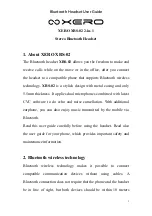
System Test
Once all bases are installed, reset the system to synchronise the bases. Then register the headsets.
1.
All headsets are registered and audio is ok
Collect all registered headsets and one by one, press the ‘Page’ button while talking to confirm
that you can hear your own voice. Repeat this step on all registered headsets.
2.
Check coverage
Take a headset and place it on TalkLock. Whilst talking on the headsets, walk around the entire
area you wish to cover noting any blind spots. The audio should be clear and free of drop out.
The side tone on the headset enables you to hear your voice broadcast so you can carry out this
exercise yourself. When you walk from the zone of one base to the zone of another, you will see
the Status LED blinking GREEN as the call is active on that particular base.
3.
Check all bases and handover
Walk around with all headsets on standby mode. As you stand in front of each base, press “page”
on one of the headsets and make sure that the Status LED starts blinking GREEN on the base you’re
nearest to. Then check the audio on the headset. Come out of talk mode and take a second
headset to repeat the same operation. Follow the same sequence and go through this procedure
on all the headsets for each Base installed.
4.
Check remote registration switch
If the remote registration wall button is installed, while wearing a headset activate both of its
functions. For registration, press for 5 seconds seconds you will hear 2 bleeps in your ear to confirm
registration is in process. For reset, keep pressing for 15 seconds you will see the power LED on the
Base turns orange>green.
5.
Check remote keypads
While wearing a headset, press all buttons on all keypads installed with a minimum of 5 seconds
between presses to make sure that you hear all messages. If presses are too fast (below 3 seconds)
the press will be ignored. Pay attention at the ID or location messages making sure that the right
keypad is placed in the correct location.
|
page
17
Summary of Contents for Q-P7BS
Page 1: ...Installation Manual...





































